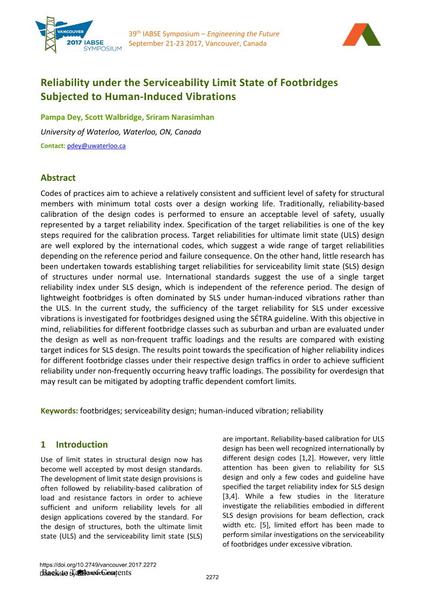Reliability under the Serviceability Limit State of Footbridges Subjected to Human-Induced Vibrations

|
|
|||||||||||
Bibliografische Angaben
| Autor(en): |
Pampa Dey
(Abstract)
Scott Walbridge (Abstract) Sriram Narasimhan |
||||
|---|---|---|---|---|---|
| Medium: | Tagungsbeitrag | ||||
| Sprache(n): | Englisch | ||||
| Tagung: | IABSE Symposium: Engineering the Future, Vancouver, Canada, 21-23 September 2017 | ||||
| Veröffentlicht in: | IABSE Symposium Vancouver 2017 | ||||
|
|||||
| Seite(n): | 2272-2279 | ||||
| Anzahl der Seiten (im PDF): | 8 | ||||
| Jahr: | 2017 | ||||
| DOI: | 10.2749/vancouver.2017.2272 | ||||
| Abstrakt: |
Codes of practices aim to achieve a relatively consistent and sufficient level of safety for structural members with minimum total costs over a design working life. Traditionally, reliability-based calibration of the design codes is performed to ensure an acceptable level of safety, usually represented by a target reliability index. Specification of the target reliabilities is one of the key steps required for the calibration process. Target reliabilities for ultimate limit state (ULS) design are well explored by the international codes, which suggest a wide range of target reliabilities depending on the reference period and failure consequence. On the other hand, little research has been undertaken towards establishing target reliabilities for serviceability limit state (SLS) design of structures under normal use. International standards suggest the use of a single target reliability index under SLS design, which is independent of the reference period. The design of lightweight footbridges is often dominated by SLS under human-induced vibrations rather than the ULS. In the current study, the sufficiency of the target reliability for SLS under excessive vibrations is investigated for footbridges designed using the SÉTRA guideline. With this objective in mind, reliabilities for different footbridge classes such as suburban and urban are evaluated under the design as well as non-frequent traffic loadings and the results are compared with existing target indices for SLS design. The results point towards the specification of higher reliability indices for different footbridge classes under their respective design traffics in order to achieve sufficient reliability under non-frequently occurring heavy traffic loadings. The possibility for overdesign that may result can be mitigated by adopting traffic dependent comfort limits. |
||||
| Stichwörter: |
Zuverlässigkeit Fußgängerstege Fußgängerbrücken
|
||||
